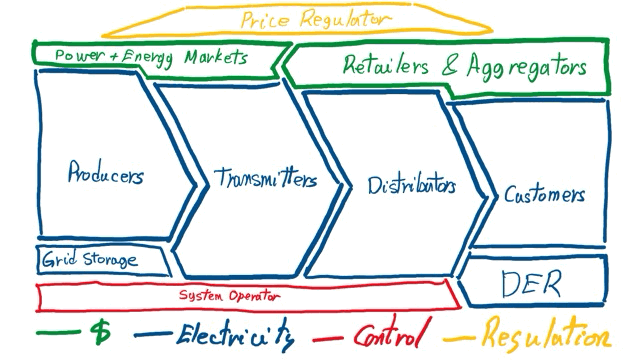
Endowed with abundant hydropower, Québec’s electricity value chain developed in its own way. For comparison, the figure below illustrates the common roles of the various players delivering electricity to the world.
In Europe, the UK, most of the US and in Ontario and Alberta, discrete actors fill each of the boxes in the diagram. Most notably, producers sell electricity on energy markets, bought by independent retailers for resale to end customers. Retailers only sell energy and they do not own the grid connecting producers to customers. Retailers can either be competitive private ventures or not-for-profit public agencies, depending on regions. The flow of electricity from producers to customers is controlled by an independent system operator. The transmission and distribution grids, which are bottleneck facilities, are regulated on price, often with reliability and cost incentives. But, overall, this is the same as you (the customer) having a wired Internet access from a phone or cable company (aka the grid) and then buying media services sold by Netflix or Apple (aka producers).
In Québec, Hydro Québec is the dominant producer, transmitter, and distributor. It has its own internal system operator and uses tenders and negotiated contracts, not a market, to buy from some independent power producers. Electricity retail is bundled with electricity distribution and there are no aggregators for peak management. There is very little grid storage (other than the vast reservoirs) and few Distributed Energy Resources (DER). The provincial regulator no longer approves spending by the utility and the electricity prices, now pegged to the consumer price index, up to 3%.
Unbundling Québec’s electricity value chain, partly or as much as it is in Europe, cannot be done without assessing the pros and cons of this approach. However, we certainly need to look how others have coped with electricity scarcity while we basked in abundance. Because, after all, there will be more scarcity than abundance in the future.